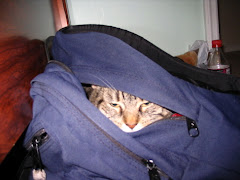 This is Banned Books Week, an annual, national anti-censorship program sponsored by the American Library Association. "Wielding the Red Pen" is a report from The University of Virginia on children's books that have faced challenges from school boards around the country. Copies of these books may be found using the World Catalog / Amazon search boxes here on BookBag.
This is Banned Books Week, an annual, national anti-censorship program sponsored by the American Library Association. "Wielding the Red Pen" is a report from The University of Virginia on children's books that have faced challenges from school boards around the country. Copies of these books may be found using the World Catalog / Amazon search boxes here on BookBag. Efforts to protect children and young adults have brought the censorship debate into school and public libraries throughout the country. Parents and school boards have subjected children's literature to the closest scrutiny, with the frequent result of challenging concepts, words, and illustrations. Successful objections have resulted in the removal of books from classrooms, library shelves, and reading lists. In other districts, schools have imposed limitations on access by placing books in restricted areas available only to children with parental approval.

Over the years, there has emerged no pattern of where censorship occurs most frequently. The red pen has been wielded as often in the North as in the South, in large school districts as in smaller ones, in rural settings as in urban ones. This case includes only a small sampling of challenged children's books, many drawn from the American Library Association's "100 Most Frequently Challenged Books of 1990-1999." Mark Twain once wrote, "In the first place God made idiots. This was for practice. Then He made School Boards." See if you agree... .

1986: A parent in Lambertville, New Jersey, objected to William Steig's The Amazing Bone on the basis that one of the animal characters uses tobacco.
1977: The Illinois Police Association objected to the portrayal of policemen as pigs in Sylvester and the Magic Pebble.
1990, 1998: According to critics, The Five Chinese Brothers includes "racial stereotypes demeaning to Chinese people" and "violent plots to execute five brothers."
1990: Classic children's stories have not escaped censorship. Little Red Riding Hood has been banned because "the presence of a bottle of wine in the young girl's basket condone[s] the use of alcohol."
1992: Judy Blume, possibly the most censored author of young adult literature in the country, writes books for and about teenagers. Their frank depiction of teenage concerns and social behavior invites strong identification from her readership but also strong objections from parents and schools. Specifically, Blubber has been challenged repeatedly because of the book's language and the lack of consequences for the characters that torment a fifth-grade classmate.
1985: Because "i t describe[s] families in a derogatory manner and might encourage children to disobey their parents," the Stupids series has been removed from shelves. This book appears as the twenty-seventh most censored book on the American Library Association's "100 Most Frequently Challenged Books of 1990-1999."
t describe[s] families in a derogatory manner and might encourage children to disobey their parents," the Stupids series has been removed from shelves. This book appears as the twenty-seventh most censored book on the American Library Association's "100 Most Frequently Challenged Books of 1990-1999."
 t describe[s] families in a derogatory manner and might encourage children to disobey their parents," the Stupids series has been removed from shelves. This book appears as the twenty-seventh most censored book on the American Library Association's "100 Most Frequently Challenged Books of 1990-1999."
t describe[s] families in a derogatory manner and might encourage children to disobey their parents," the Stupids series has been removed from shelves. This book appears as the twenty-seventh most censored book on the American Library Association's "100 Most Frequently Challenged Books of 1990-1999." 1992: Maurice Sendak's In the Night Kitchen has been found objectionable because of the nudity of the main character, a young boy, promoting allegations that this nudity might encourage child molestation. In Springfield, Missouri, the book was expurgated by drawing shorts on the nude boy. The American Library Association ranks In the Night Kitchen twenty-first on its list of "100 Most Frequently Challenged Books of 1990-1999."
Maurice Sendak's classic Where the Wild Things Are has been challenged for involving "witchcraft/supernatural elements."
1999: According to the American Library Association's Office of Intellectual Freedom, the Harry Potter series stands as the most challenged book of 1999
1991: Charged with being "racist" and "extol[ling] the virtues of a European middle-class lifestyle and disparag[ing] the animals and people who have remained in the jungle," The Story of Babar has been labeled Eurocentric by its detractors.
1959: In Montgomery, Alabama, the public library relegated The Rabbits' Wedding to a "reserve" shelf because illustrations showed an "interracial" rabbit couple in which "the buck was black and the doe was white."










No comments:
Post a Comment